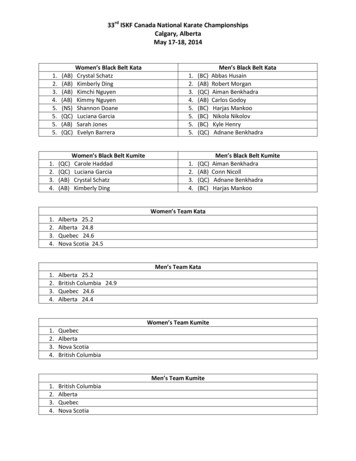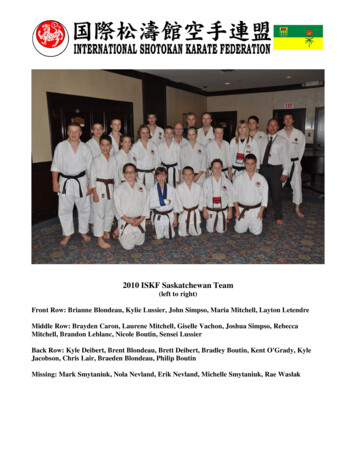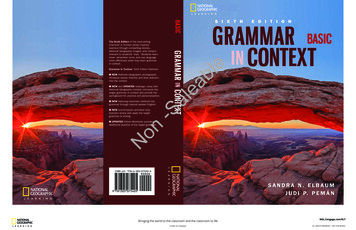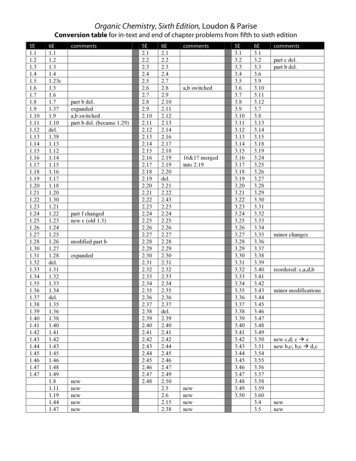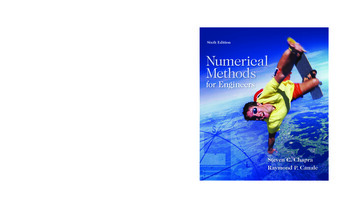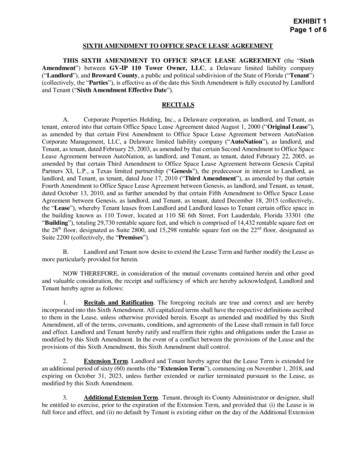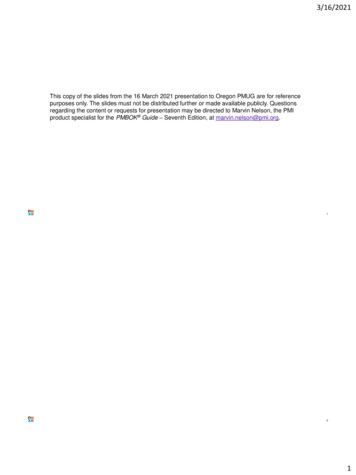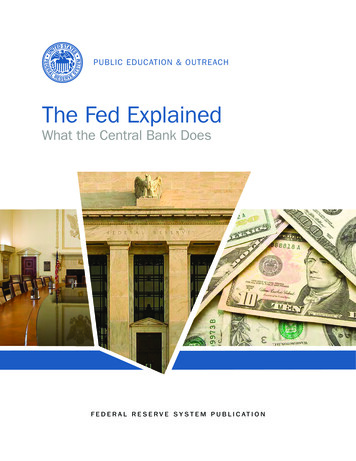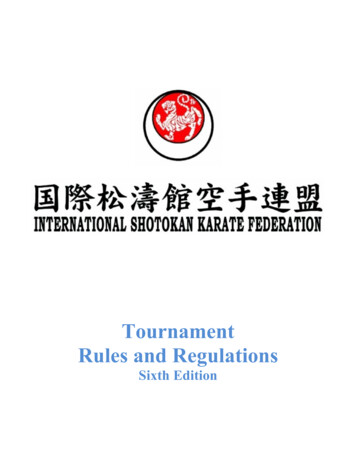
Transcription
TournamentRules and RegulationsSixth Edition
(THIS PAGE IS INTENTIONALLY LEFT BLANK)
ISKF TECHNICAL COMMITTEERULE CHANGES(i)Any amendments to the rules contained herein shall require a two-thirds majority vote of themembers of the Technical Committee and final approval by the Shihankai of theInternational Shotokan Karate Federation.(ii) The rules of this manual, having been issued on September 1, 1978, have been revised andimplemented October 2008 (1st Ed.), May 2009 (2nd Ed.), August 2013 (3rd Ed.), August2014 (4th Ed.), August 2016 (5th Ed.), and December 2017 (6th Ed.) 2018 International Shotokan Karate Federation*Edits Dec. 2017 – pgs. 1, 2, 26, 29, 33, 35, 36, 39, 40, 41, 42, 43.ISKF CHAIRMAN AND CHIEF INSTRUCTORShihan Hiroyoshi Okazaki, 9th DanISKF TECHNICAL COMMITTEE CHAIRMANShihan James Field, 8th DanISKF TECHNICAL COMMITTEE VICE-CHAIRMANShihan Robin Rielly, 8th Dan
TABLE OF CONTENTSARTICLE I. GENERAL RULES1Section 1.01Philosophy & Oath of Contestant1Section 1.02Levels of Tournaments1Section 1.03Age Divisions2Section 1.04Rules of Conduct for All Participants2Section 1.05Additional Information3ARTICLE II. TOURNAMENT OPERATIONS4Section 2.01Administration of Karate Contests and Tournaments4Section 2.02Tournament Officials7Section 2.03Tournament Staff10Section 2.04Equipment11Section 2.05Dress Code for Participants11Section 2.06Set-up of Courts13ARTICLE III. KUMITE EVENTS14Section 3.01Definition of Individual Event14Section 3.02Definition of Team Event14Section 3.03Conduct Of Kumite Matches15Section 3.04Duration Of Kumite Matches15Section 3.05Scoring16Section 3.06The Rules Of Judging Kumite16Section 3.07Procedure and Operation Of Kumite Matches18Section 3.08Definition & Criteria For Scoring Points In Kumite20Section 3.09Criteria For Reaching An Outcome In a Kumite Match21Section 3.10Criteria Leading To Disqualification In Kumite22Section 3.11In the Case Of Injury In Kumite24Section 3.12Degree Of Contact In Kumite24Section 3.13Protests and Other Matters In Kumite25ARTICLE IV. KATA EVENTS26Section 4.01Definition & Guidelines of Event26Section 4.02Selection of Match System26Section 4.03The Rules of Judging Kata26Section 4.04Procedure and Operation of Kata Matches28Section 4.05Criteria For Point Deduction & For Disqualification in Kata30i
ARTICLE V. YOUTH COMPETITIONS33Section 5.01General Rules33Section 5.02Individual Competition33Section 5.03Team Competition34Section 5.04Contest Rules34Section 5.05Warnings, Fouls and Disqualifications36ARTICLE VI. APPENDICESSection 6.0139Rules Specific To Individual CountriesUSA: Collegiate Competition39Section 6.02Japanese Pronunciation43Section 6.03Sample Tournament Setups44Section 6.04Match Area - Ring Dimensions46Section 6.05Judges Positions47Section 6.06Methods of Individual Kumite48Section 6.07Methods of Team Kumite50Section 6.08Flag Decision Table52Section 6.09Whistle Signals and Terminology52Section 6.10Referees Terms and Their Meanings53Section 6.11Kumite Scoring Areas55Section 6.12Referee Signals56Section 6.13Judges Signals58Section 6.14Tournament Form - Individual Final Kata59Section 6.15Tournament Form - Individual Final Kumite60Section 6.16Tournament Form - Team Kata61Section 6.17Tournament Form - Team Kumite620
Article I.General RulesSection 1.01Philosophy & Oath of Contestant(a) Philosophy(i)Karate contests are an extension of dojo training and must therefore be conducted in thespirit of karate-do.(ii) Contestants:1)All contestants must respect and observe the proper forms of etiquette toward officials,Judges, and fellow contestants. They must do their utmost to compete with courage,dignity, and honor, and to uphold the precepts of the Dojo Kun. These values takeprecedence over winning or losing.(iii) Judges:1)To uphold the integrity and reputation of the officials, Judges must be fair and impartial.All Judges must give their undivided attention to the match and observe each movementof the contestants in order to make as accurate a decision as is humanly possible.(b) Qualifications of participants(i)ISKF member in good standing(c) Oath of Contestants(i)Sensei:(ii) On behalf of the contestants of the (insert name of tournament), I pledge to compete withcourage, dignity and honor. Sensei, I will abide by the rules of the ISKF Karate-doTournament and comply with any decision of the Chief Judge, Referees, and Judges in thetrue spirit of karate-do.(iii) Osu!(iv) (After reading, present oath to the Chairman and Chief Instructor)Section 1.02Levels of Tournaments(a) These rules and regulations shall apply to the following ISKF sanctioned tournaments:(i)ISKF World Shoto Cup Tournaments(ii) International Regional Tournaments(iii) National Tournaments1
(iv) Domestic Regional Tournaments(v) Dojo TournamentsSection 1.03Age Divisions(a) These rules and regulations shall apply to the following ISKF sanctioned age divisions:(i)Youth – 7-17 years of age. (Up to five divisions allowed – see 5.02 (a))(ii) Junior Adult – 18-21 years of age; separate male and female kata and kumite divisions.(iii) Adult – 22-44 years of age; separate male and female kata and kumite divisions.(iv) Senior Adult – 45-54 years of age; separate male and female kata and kumite divisions.(v) Super Senior – 55-64 years of age; separate male and female kata and kumite divisions jiyu ippon kumite only.(vi) Super, super Seniors – 65 years of age; kata only.Section 1.04Rules of Conduct for All Participants(a) Assembly Area(i)Judges and contestants shall not sit among the spectators.(ii) Separate areas shall be set aside for the Judges, and, for the contestants. They shall remainthere when they are not actively participating in the tournament. The area must be areasonable distance from the contest area.(iii) A warm-up area will be designated for contestants scheduled to participate in an approachinground of competition. When the round is completed, the contestants will return to theirdesignated area.(b) General Behavior(i)Loud and tumultuous behavior will not be tolerated.(ii) In the event of a controversial decision by a Referee or Judge, a team coach may seek redressof the decision through the Ring Arbitrator.(iii) The Ring Arbitrator makes the final decision. In the majority of cases this should besufficient. If a controversy still exists, it may be brought to the attention of the ChiefArbitrator whose decision will be final.(iv) Verbal disruptive coaching is not permitted.2
(c) Contestants’ Behavior(i)Failure of contestants to immediately and courteously obey any instruction by the Refereemay result in disqualification as per Section (e) - Penalties.(d) Judges’ Behavior(i)Judges are prohibited from acting in the capacity of a coach; this is the responsibility of theappointed team coach.(e) Penalties(i)A contestant, coach, instructor, Judge or Referee found guilty of violating the rules ofconduct may be suspended from participating further in the said tournament, or any ISKFsanctioned tournament for one calendar year. Serious offences may lead to loss ofmembership in the ISKF. This is subject to the decision of the Chief Instructor or theTechnical Committee.(ii) A one calendar year suspension shall be interpreted as one calendar year from the date of theoffence.1)Section 1.05If an individual is suspended January 1 of the current year, and the next annual event isheld January 1 of the following year, the suspension is lifted. However, if the tournamentis held December 31 of the current year, the suspension is still in effect.Additional Information(a) If a situation undefined in the present document, arises, the decision shall be given by theChief Judge.3
Article II.Tournament OperationsSection 2.01Administration of Karate Contests and Tournaments(a) The contest is a part of karate leading to the accomplishment of its training objectives. Theseevents may be a potential source of aid in the evaluation of training methods, and as such, shouldbe well-organized and efficient operations based on solid rules and guidelines. As an aid tosponsoring well-conducted events, it is recommended that the points listed below be considered.(b) The precise amount of pre-contest, contest, and post-contest preparation is entirely dependentupon the type and level of contest/tournament being conducted. The following is not anexhaustive study of each type, but rather a checklist for a minimum set of requirements.(c) Pre-Contest Preparations(i)Good organization places the overall supervision and responsibility for the event in the handsof a tournament director. This job should be assigned to a highly experienced karateexponent who has both technical and administrative abilities. The tournament director shouldbe a noncompeting karate exponent in as much as the nature of the job precludesconcentration on the actual competition.(ii) In smaller events, the tournament director performs almost all duties required to bring off asuccessful event, but may delegate various tasks to other personnel. In larger events,experience has proven that separate committees should be appointed to achieve speciallyassigned tasks for the tournament director, who must then coordinate all committeefunctions.(iii) The tournament director is, in the final analysis, the source of tournament management and isresponsible for what the event achieves or fails to achieve. The following checklist willsuggest a handy guide to preparations.1)Duties of the Tournament Directora)2)The tournament director advises and supervises the overall administration of allactivities pertaining to the scheduled event, and assigns specific committees asrequired.Duties of the Tournament Committeea)Prepare the tournament budget.b)Prepare, distribute, and receive returned entry forms.c)Obtain trophies and/or medals.d)Obtain necessary equipment for officials (stopwatches, time clocks, bell-gong,whistles, red and white flags and belts, contest forms, pencils, scratch paper, andrulers.)4
e)Train volunteers for ring management, score keeping, recorders, time keeping, andring maintenance dutiesf)Acquire necessary licenses and permits.g)Obtain and check tournament site and facilities (contest area, seating for spectatorsand participants, lockers, showers, lavatories, tables and chairs for officials, andpublic address system).h)Appoint ticket sellers-takers, ushers, and announcers.i)Identify accommodation for visiting competitorsj)Arrange for first-aid personnel and/or tournament doctor.k)Handle finances for necessary disbursements.l)Prepare invitations for special guests and officials.m) Prepare intermission and rest period demonstrations.3)4)Duties of the Publicity Committeea)Solicit advertisements for the contest program.b)Solicit publicity in the form of television, radio, newspaper, magazine coverage,posters, exhibition, and demonstration-lecture media.c)Seek out financial assistance through contest sponsor(s).Duties of the Technical Committeea)Make pre-tournament pairings. Check competition ladders prior to the first match toensure, if possible, that competitors from the same dojo or region are not paired in thefirst round.b)Provide officials (Referees and Judges).(d) Contest Day Preparations(i)The day of the tournament should find all in readiness except reasonable last-minute detailswhich cannot be attended to earlier. Outstanding among these is the physical checking-in ofall officials and contestants. Officials should congregate at least an hour prior to contest timein order to familiarize themselves with all details and to provide the necessary technicalassistance for the conduct of the matches.5
(ii) As contestants check in, certain vital statistics must be properly recorded such as names, clubaffiliations, ranks, etc. In the event that pre-contest pairings were not utilized, such vitalstatistics become increasingly important and strict accuracy must be maintained in theirrecording. Pairings should be made by experienced pairing officials in order to derivemaximum benefit from the combinations of contestants.1)2)3)Duties of the Tournament Committeea)Sell tickets and programs.b)Provide usher service.c)Meet and aid visiting competitors.d)Assign announcers, ring managers, timekeepers, scorekeepers, and recorders.e)Assist Publicity Committee in its duties.f)Provide cleaning and policing of area.g)Provide first-aid services and/or tournament doctor stations.Duties of the Publicity Committeea)Arrange for coverage of matches by media.b)Contact news media not present at tournament regarding tournament results.Duties of the Technical Committeea)Conduct officials’ meetings.b)Make rulings on all special requests by participants (Special Religious Dress, etc.).c)Assign ring officials (Ring Arbitrators, Referees and Judges).d)Conduct matches.The actual contest time is one of extreme rapidity of events, thus the officials actually engaged inthe conduct of the matches must be isolated as much as possible from miscellaneous detailswhich tend to hamper proper supervision of the matches. Tournament and Publicity Committeemembers should make every effort to respect this fact and utilize their initiative in solvingproblems that arise.The physical arrangements of the various officials’ tables should be carefully studied. Efficientoperations require that the contest area be located so as to permit certain perimeter activitieswithout interfering with the action in the contest area. These perimeter activities include viewingof the contestants by substitute Referees and Judges, guests of honor, tournament director, andmedical doctor as well as the scorer, recorder, and timekeepers. The announcer should also begiven a place in the perimeter area.6
Special provisions are made for the competitors in order that they may be grouped in an orderlymanner, thus causing no delay in the matches. Unnecessary mixing of the competitors with thespectators or official tournament perimeter activities produces straggling and greatly hindersefficient tournament operation.(e) Post-Contest Activities(i)Post-contest activities are vital to efficient tournament procedures and to obtain themaximum benefit from the event within karate training objectives. Post-contest activities areoften regarded as activities left to junior members to carry out. Overall supervision of theTournament Director/Manager should continue unabated until all assigned work iscompleted. The following checklist may be helpful:1)Post-Tournament Duties of the Tournament Committeea)Completely record all match records for proper distribution to files, visitingorganizations, etc.b)Check tickets versus cash receipts.c)Report finance results to the appropriate committee.d)Secure and return all facilities and properties to satisfactory condition.e)Prepare and distribute letters of thanks and appreciation.2)The Karate Tournament in Retrospecta)Section 2.02Regardless of its intended purpose, each contest and surrounding event is a source oftraining. It is an exercise in both the technical and administrative aspects of karate.Whether designed as a championship or other event, contests should bringunderstanding to each and every participant, official and contestant.Tournament Officials(a) Chief Judge and Chief Arbitrator(i)As a general rule, the ISKF Chief Instructor will preside as the Chief Judge in the WorldShoto Cup as well as the Pan-American Championships.(ii) In national championships, the Chief Judge and the Chief Arbitrator will be appointed by theChief Instructor of the country. In regional tournaments, these positions will be appointed bythe regional Chief Instructor. The Chief Instructor may also appoint a Vice-Chief Judge anda Vice-Chief Arbitrator as needed.(iii) Since the roles of Chief Judge and Chief Arbitrator have a supervisory component, bothofficials should locate themselves so they may observe activity in the rings. Generally thiswill place them at the head table. However, there will be times when it will be advisable tovisit various rings to better observe the activities of the Judges and Ring Arbitrators.7
(b) Chief Judge(i)The Chief Judge is responsible to maintain a fair and smooth course of occurrence of allevents in a given tournament(ii) The Chief Judge is responsible to provide appropriate decisions in the following situations:1)If there is an issue with the rules and regulations or if unfairness has been identified2)If there is a matter exceeding this present document3)If there is an accident(iii) If a situation has occurred, after consulting with the Ring Arbitrator, Referee and Judges, andChief Arbitrator, the Chief Judge will take action as per the following:1)Give special advice or instructions2)Banish from the tournament3)Disqualify a competitor from the tournament4)After consultation with the Referee and Judges, the Chief Judge will decide the durationof disqualification and if it applies to further tournaments.(c) Referee and Judges(i)The Referee and the Judges are responsible for a match or event and make decisions during agiven match or event(ii) The Referee and the Judges exert control over the surroundings of the match or event as well.(iii) The Referee and the Judges are solely responsible for the outcome of the match or event andcannot be challenged with the exception of the Ring Arbitrator and Chief Arbitrator.(iv) The Referee coordinates the match or event and gives the final decision regarding theoutcome of the match or event.(v) The Judges assist the Referee by indicating their own decisions during the match or event.(vi) The Referee and the Judges are selected amongst the pool of certified Judges and appointedto their positions by the Chief Judge.(d) Chief Arbitrator(i)The Chief Arbitrator will be available to advise ring arbitrators and to settle problems that thering arbitrators cannot handle.8
(e) Ring Arbitrator(i)One Ring Arbitrator shall be stationed at each ring.(ii) The Ring Arbitrator is selected and appointed to the position by the Chief Judge.(iii) A Ring Arbitrator is responsible for the following:1)That the Referee and the Judges have appropriate qualifications for the tournament.2)That the competitors have appropriate qualifications as well.3)That the rules and regulations are being followed.(iv) A Ring Arbitrator is responsible to provide appropriate decisions to the Referee and Judges,timekeepers and scorekeepers in the following situation: if the head coach has a question orprotest.(v) A Ring Arbitrator if necessary, can consult the Referee, Judges, or support personnelinvolved.(vi) The Ring Arbitrator will attend judge's conferences called by the Referee during the match.The Ring Arbitrator's role during this conference will be to ensure that the rules are beingfollowed and answer questions raised in regard to the rules and procedures. The RingArbitrator will not have a vote in scoring.(vii) The position of Ring Arbitrator will be rotated among the senior judges present.(viii) The Ring Arbitrator will document the scores during the match and perform other duties asneeded.(f) Competitors(i)If the competitors are qualified, the Host Organization cannot refuse their participation in atournament.(ii) As a general rule, the competitors are active members of the ISKF.(g) Head Coach(i)One Head Coach can be present for his competitor during a match or event(ii) A Head Coach must be registered with the Host Organization prior to the Tournament.(iii) If a Head Coach has a question or protest regarding a match or event, it has to be addressedto the Ring Arbitrator.(iv) A Head Coach cannot give advice or coach a competitor from outside the ring during a matchor event.9
Section 2.03Tournament StaffThe number of personnel shall be determined by the tournament host and stationed atappropriate locations with the following duties:(a) Announcer(i)The announcer will call the contestants to their appropriate position (aka/shiro) and then willdirect the contestants throughout the match by announcing their name (or number) andwhether they are ‘on deck’ or ‘in preparation’ and/or to enter the ring.(ii) Kata events - When the point system is used, the announcer will stand and announce thescores starting with the Referee and continuing clockwise around the ring of Judges, pointingto each score as they announce it. In addition, the announcer shall receive the total pointsfrom the recorder and announce them.(b) Recorder(i)When the flag system is used, the recorder will note on the recording forms the decisions andessential remarks of the match. In kumite matches, the appropriate Referee decisions must bedocumented (e.g. ippon, waza ari, jogai, chui, etc.)(ii) When the point system is used, calculation sheets and forms will be accurately computedfrom the points announced. The name of the contestant, their kata, and the winner of thematch must be recorded accurately.(c) Facility Crew(i)Concerns itself with the progress of the match.(ii) Communicates with the contestants and Judges.(iii) Prepares the match area.(iv) Carries out other duties as determined by the tournament host.(d) First Aid Personnel(i)Keeps first aid equipment on hand.(ii) Prepares a place to care for the injured.(iii) A medical doctor should be present and must be stationed in a designated area.(iv) Arrange transport to medical facility in cases of emergency.(v) Performs other duties as determined by the tournament host.10
Section 2.04Equipment(a) Required Equipment – Kumite Matches(i)Red and white flags(ii) Red ribbons or belts(iii) Standard recording forms (see Section 6.14–6.17)(iv) Stop watch(v) Bell or buzzer(vi) Kumite scoreboards(b) Required Equipment – Kata Matches(i)Red and white flags(ii) Kata score cards(iii) Kata selection cards(iv) Red ribbons or belts(v) Recording materialsSection 2.05Dress Code for Participants(a) The Referees and Contestants must wear the official uniform as defined below.(b) The Technical Committee may prohibit any official or competitor from participating whodoes not comply with this regulation.(c) Referees and Judges(i)Must wear the official uniform as set out by the ISKF Technical Committee. This uniformmust be worn at all tournaments. (Unless otherwise approved by the Chief Referee of theTournament).(ii) A single-breasted, navy blue blazer.(iii) A white long sleeve ISKF regulation dress shirt with standard collar, tucked inside of pants.(iv) A maroon or wine color ISKF regulation tie, neatly tied at the collar.(v) Plain light grey dress trousers.(vi) For one-day tournaments (including camp tournaments), judges shall wear a karate gi.11
(vii) For local, regional, or national tournaments lasting two days, judges shall wear a karate gi onday one, and official uniform on day two.(viii) For international tournaments, judges shall wear official uniform for all days of tournament.(d) Contestants(i)Must wear a clean white karate gi with ISKF patch on left chest.(ii) The jacket should be loose and long enough to cover at least half of the buttocks. The sleevesmust fall about midway between the elbow and the wrist. Sleeves must not be rolled up.Female contestants must wear a white t-shirt or white sports bra under their jacket.(iii) The pants must be loose and the length must fall about midway between the knee and theankle. The bottom of the pants must not be rolled up.(iv) For international tournaments, the national flag of the country may be worn on the leftshoulder of the jacket and may not exceed 12cm. 8cm. Following the Internationaltournament, the flag must be removed from the sleeve.(v) The belt must be long enough to go twice around the waist. It is tied with a square knot withsufficient length to allow at least twenty-five centimeters free on each side of the knot.During a contest, one competitor wears a red ribbon or belt.(vi) Contestants shall keep their nails short and shall not wear metallic objects or any otherobjects on their person that may cause injury to their opponents or themselves.(vii) No jewelry of any kind may be worn by both males and females. The use of metallic teethbraces must be approved by the Referee and the official doctor, and the contestant / parent /guardian must accept full responsibility for any injury.(viii) Hair slides and metal hairgrips are prohibited. Any hair apparel that is considered by theReferee to be potentially dangerous is not permitted.(ix) Eyeglasses are not allowed, not even the “safety” type of glasses. Soft contact lenses may beused at the contestants own risk. If contact lenses fall out during a match, the contestant maybe allowed a maximum of one minute, or longer at the discretion of the Referee, to find,replace, or do without it, before the match is continued. In the event that they cannotcontinue, they may forfeit the match.(x) White sparring gloves and mouth guards are compulsory. Only ISKF approved gloves madewith non-blood-absorbent material that may be easily cleaned with a bleach disinfectantsolution may be worn.(xi) Bandages and/or safety devices may be permitted if approved by the Referee on the advice ofthe official doctor.(xii) Junior and female chest protectors may be used but must be worn inside the gi jacket; it mustbe white in color and small enough so that it does not impede the free movement of thecontestant’s upper body and arms. Groin guards (shatter proof type) are not mandatory but ifworn must be done so at the contestants own risk.12
(xiii) The wearing of unauthorized dress or equipment is forbidden. Contestants wishing to wearwhat would be considered unauthorized dress on religious grounds may do so subject to theapproval of the Technical Committee in advance of the contest.(xiv) If a contestant comes into the competition area improperly dressed, they will be given oneminute to remedy the matter. If they refuse to comply or are unable to do so in the timegiven, they may be disqualified.Section 2.06Set-up of Courts(a) Kumite Match Area(i)The match area shall have a flat surface with necessary measures taken for the prevention ofhazards (See Section 6.04).(ii) Wooden floors are preferred. However, tatami (foam or rubber mats) or other suitablesurface may be used as long as it is flat and smooth.(iii) The size of the match area, in principle, shall be eight meters square (See Section 6.04).(iv) The match area shall have a safety area two meters wide surrounding its perimeter.(v) Two parallel lines, each one meter long, indicated by a red tape on the right of the Refereeand a white tape on the left of the Referee, shall be placed at a distance of 1.5 meters fromand on both sides of the center point of the match area. These shall be the standing lines forthe contestants. An additional line, one meter long, shall be drawn at a distance of 1.5 metersfrom the center and perpendicular to the contestant standing lines. This shall be the linewhere the Referee stands at the beginning of a match.(b) Kata Match Area(i)The match area shall have a flat surface with necessary measures taken for the prevention ofhazard.(ii) Wooden floors are preferred. However, tatami (foam or rubber mats) or other suitablesurface may be used as long as it is flat and smooth.(iii) There is no standard size. The size shall be such that the participants are able to perform thekata without any obstacles and the floor shall be border lined as in kumite.13
Article III.Kumite EventsSection 3.01Definition of Individual Event(a) An individual match is decided by ippon or sanbon shobu (two or three minutesrespectively).(b) Individual matches are of three types:(i)Tentori Shiai (Single Elimination)(ii) Soatari Shiai (Round Robin)(iii) Kachinuki Shiai (Winner Continue)(c) For characteristics of individual kumite matches see Section 6.06.Section 3.02Definition of Team Event(a) The number of persons comprising a team shall be an odd number.(b) Matches between individual members of each team shall be held (ippon shobu) in apredetermined order and the winner of a team match shall be decided on the basis of theseindividual matches.(c) Team matches shall be conducted according to two methods:(i)Tentori Shiai is the method of deciding a winning team on the basis of the number ofindividual matches won.1)Under this method (hereinafter referred to as the number of winners method), the finalteam result shall be decided on the basis of the number of individual winners. However,when the number of winners from the two teams is the same, the team which has scoredmore ippon or quality of wins shall be the winning team. In case both teams are equal, thematch shall be decided on the basis of, and in the order of “awase waza,” and decisionwin. Victories won through a foul or disqualification of the opponent shall be counted asippon. When a team ties with the opposing team under these methods of decision asmentioned above, the decision shall be made on the basis of the results of an extra matchconducted between the representatives of the contending teams.2)The extra match shall be fought between one chosen representative from each team,repeatedly and successively, until a winner is established. However, in case the numberof extra matches is extended beyond two, the representative from each team shall bereplaced by another member of each team.(ii) Kachinuki Shiai is the method of successive winning carried out until the opposing team hasexhausted its contestants.1)Under this method, hereinafter referred to as the successive winning method, the winneremerging from an individual match shall continue to fight new contestants from the14
opposing team until he is defeated and the victory shall be awarded to the team whosemember defeated the last contestant of the opposing team. A system of limited successivewins (under which a contestant or contestants who successively won three to fiveindividual matches are withdrawn from the match) may be adopted.(d) For characteristics of team kumite matches see Section 6.07.Section 3.03Conduct Of Kumite Matches(a) The contestants shall take their positions, with toes behind the lines, bow to one another and,
courage, dignity and honor. Sensei, I will abide by the rules of the ISKF Karate-do Tournament and comply with any decision of the Chief Judge, Referees, and Judges in the true spirit of karate-do. (iii) Osu! (iv) (After reading, present oath to the Chairman and Chief Instructor) Section 1.02 Levels of Tournaments
